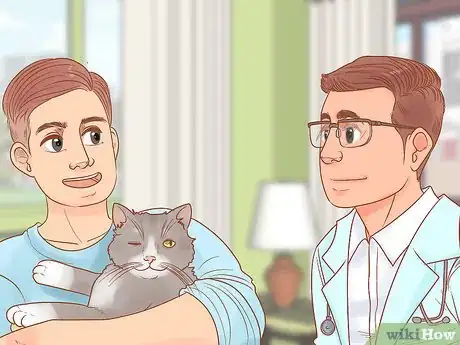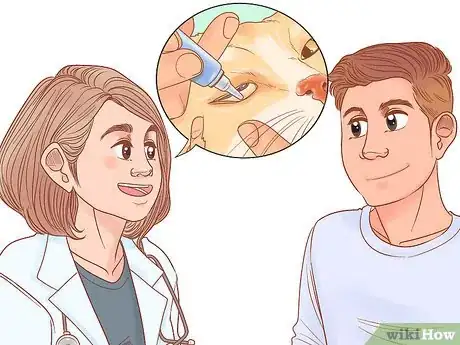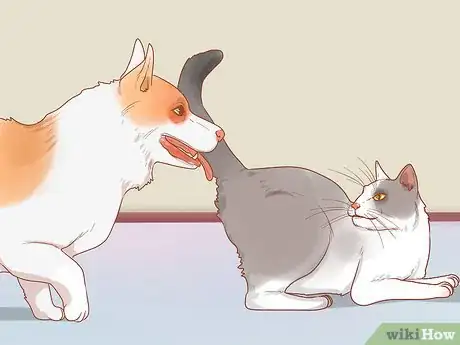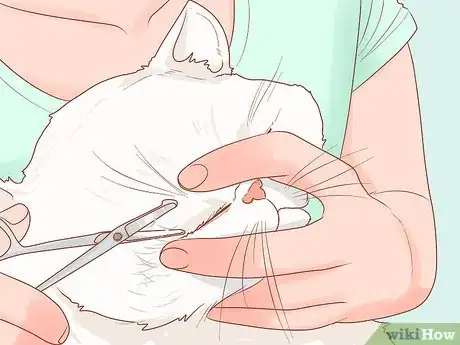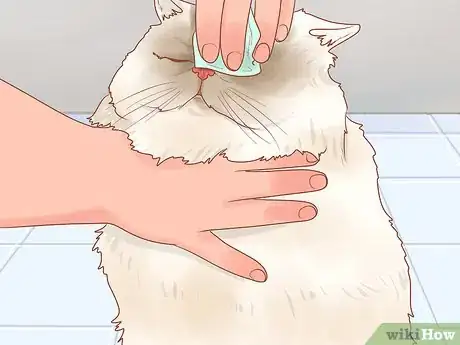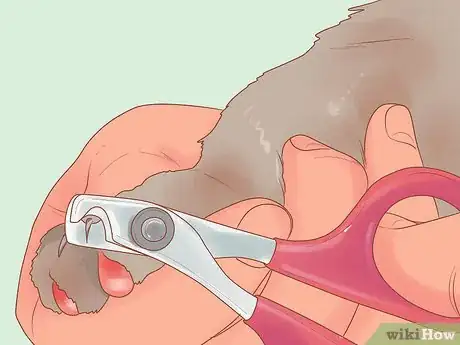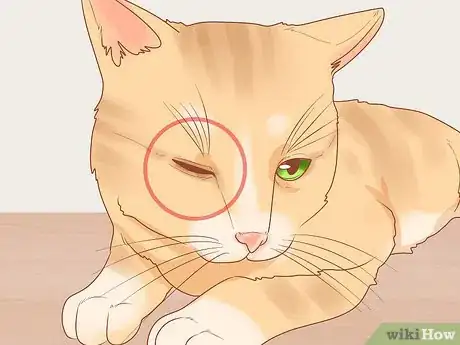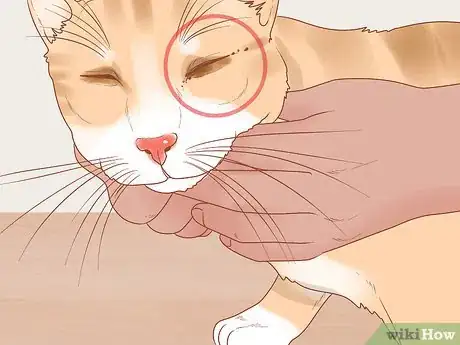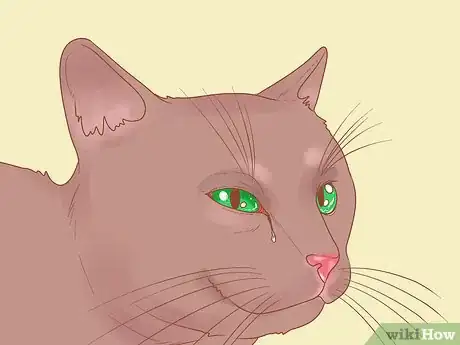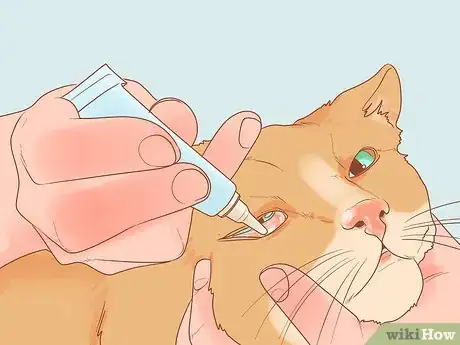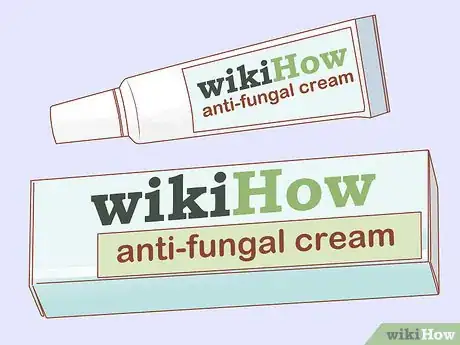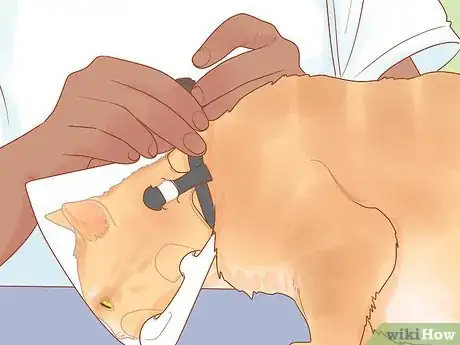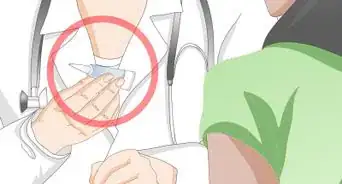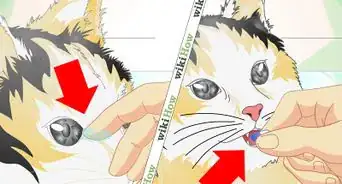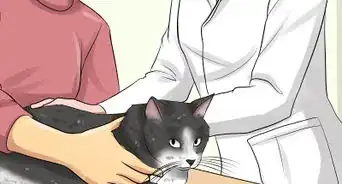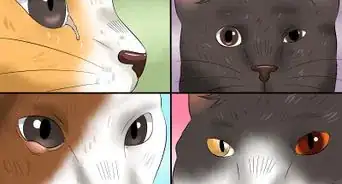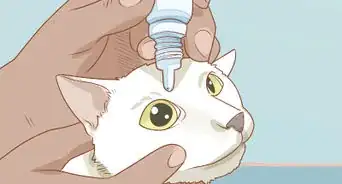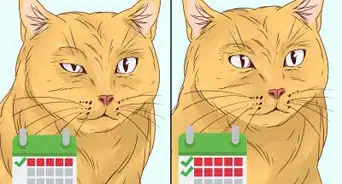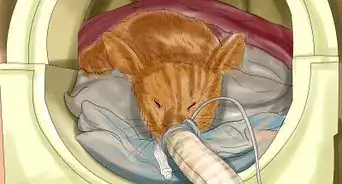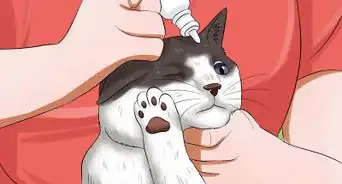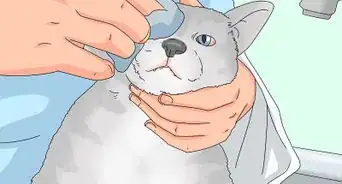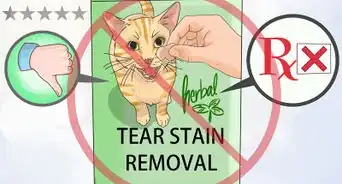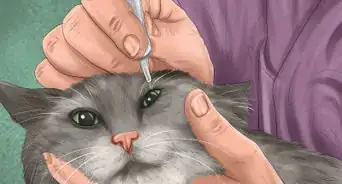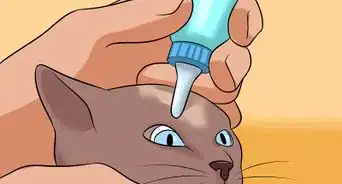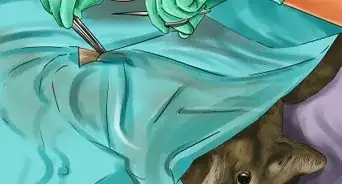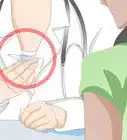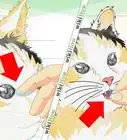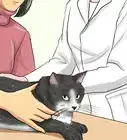This article was co-authored by Melissa Nelson, DVM, PhD. Dr. Nelson is a Veterinarian who specializes in Companion and Large Animal Medicine in Minnesota, where she has over 18 years of experience as a veterinarian in a rural clinic. She received her Doctor of Veterinary Medicine from the University of Minnesota in 1998.
There are 11 references cited in this article, which can be found at the bottom of the page.
This article has been viewed 9,125 times.
While somewhat rare, cats can develop a variety of eye problems that may potentially threaten their vision or overall health. Outdoor cats, especially, are susceptible to a number of eye problems. However, by taking steps to prevent eye problems, watching for eye problems, and treating certain eye issues, you’ll be better able to protect your cat’s eyes.
Steps
Taking Preventative Action
-
1See your veterinarian regularly. Visiting your veterinarian regularly will help you stay attuned to any developing conditions. Very often, eye problems are indicative of larger underlying problems. Ultimately, routine physical examinations and bloodwork may make it so you can head off any eye problems.
- Have your cat seen by a vet annually or semiannually.
- Notify your vet if you think your cat has allergies or other conditions, like runny eyes.
- Contact your vet immediately if you notice your cat has any eye problems.[1]
-
2Follow your vet's treatment plan to prevent further damage. Even if your cat's eyes are healthy now, allowing another condition to go untreated can cause eye problems later on. Many illnesses in cats can affect the eyes, causing issues like cataracts, glaucoma, and loss of sight.
- Diabetes can cause the blood vessels in your cat's eyes to narrow, resulting in blindness.[2]
- Diseases like FIV, feline leukemia, and toxoplasmosis can cause retinal detachment, glaucoma, and inflammation that can result in loss of eyesight.
- Hypertension, kidney issues, and hyperthyroidism can cause your cat to lose its vision, have hemorrhaging in its eye, or have retinal detachment.
- Eyelid inflammation can be caused by scabies, ringworm, and immune medicated skin diseases.
- Conjunctivitis can result from feline herpes, chlamydia, and mycoplasma.
- Cornea damage can also be caused by feline herpes.[3]
Advertisement -
3Monitor your cat’s interactions with other pets. A somewhat common cause of eye problems in cats is injury inflicted by another pet. Whether it be friendly playing or a minor fight, your cat’s eyes could get scratched and become infected.
- Supervise interactions between animals that don’t get along.
- Watch how new pets interact with other pets for the first days or weeks after you get them.
- Separate animals that may get into fights.
- If your cat's eye is injured, consider it an emergency and take your pet to the vet immediately.
-
4Maintain proper nutrition. Protecting your cat’s eye health involves maintaining proper nutrition. Without the right nutrition and vitamins, your cat’s eyes could suffer and be more susceptible to infection or other problems.
- Make sure your cat consumes enough beta-carotene and vitamin A.
- Provide your cat with a food that is specially formulated for their lifestyle. For example, if your cat is an outdoor cat, make sure they eat food that provides them with the nutrition they’ll need to thrive outside.
- Change your cat’s food if you think it causes an allergic reaction that irritates their eyes.[4]
- Always use a commercially prepared, high quality food to ensure that your cat's nutritional needs are met.
-
5Trim eye hair. If you own a long-haired breed, you should trim their eye hair regularly. This is important, as eye hair accumulates debris and bacteria that could lead to an infection. To do this, take safety scissors and trim hair that is longer than an inch in length.
- If you're uncomfortable trimming your cat's eye hair, consult a groomer or your veterinarian.[5]
-
6Wipe your cat's eyes. Cats, like dogs and people, often have discharge from their eyes. This discharge could accumulate bacteria or get lodged in the eye at some point. Because of this, you should wipe your cat's eyes regularly with a warm wet rag.
- Make sure the rag is clean and soft. You don't want to introduce bacteria or hurt your cat.
- Never wipe your cat's cornea with the rag because this can cause injury. Only clean around the eye.
-
7Cut your cat's nails. By cutting your cat's nails regularly, you'll decrease the chance that they accidentally scratch themselves in the eye. This is important, as scratches may lead to infections and serious eye problems.
- When trimming your cat's nails, always make sure to cut below the quick (the fleshy part of the nail). Do not cut where you see pink in the nail. Trim ONLY from the curve of the nail to the end (the sharp part). Be careful not to cut the nail too short, stay near the end of the nail. Cutting the quick could cause your cat a lot of pain.[6]
Watching for Problems
-
1Look for signs of discomfort. There are variety of signs of discomfort that could indicate something is wrong with your cat’s eyes. If your cat shows any sign of discomfort or any sign that their eyes are bothering them, you should contact your vet.
- Watch to see if your cat tries to scratch or rub their eyes.
- Look to see if your cat blinks a lot or acts as if something is lodged in their eyes.[7]
-
2Watch for crust or buildup around the eye. One of the most obvious signs of eye problems is a buildup of crust or other material around the eye. Most of the time, this indicates some sort of infection or related problem.
- If you notice buildup, you should contact your vet immediately.
- The crust may appear green or yellow. In some cases, the buildup could be dark brown or black.[8]
-
3Note tears or watery discharge. If you see that your cat seems to have tears or watery discharge coming from their eyes, they could have a potentially serious eye problem.
- These eye problems could be caused by infection or allergies.
- Watery discharge could be worse at certain times of the day or could occur throughout the day.[9]
-
4Observe changes in the appearance of your cat’s eyes. Any change in the eye is likely a symptom of a potentially serious eye problem. You should contact your vet if your cat's eyes appear:
- Red
- Cloudy
- Milky[10]
Treating Infection and Other Issues
-
1Apply antibiotics. If your cat has an infection, your vet will likely prescribe an antibiotic. You’ll be able to give your cat antibiotics as a pill, drops, or a topical cream. Without antibiotics, your cat may not be able to fight off the eye infection.[11]
-
2Use anti-viral or anti-fungal cream. In some cases, eye issues may be caused by a virus or fungus. If this is the case, your vet will prescribe an anti-viral or anti-fungal cream. The cream will fight the virus or fungus and help your cat’s eye to heal.
- Your doctor may opt to prescribe anti-viral or anti-fungal drops instead of a cream.[12]
-
3Use an Elizabethan collar, if necessary. Elizabethan collars are cone-like devices that fit around your cat’s neck. They will prevent your cat from scratching their eyes.
- If your cat has an infection, has had a surgical procedure, or has some other issue, you may need to fit them with an Elizabethan collar.
- Your cat will have to wear the collar until their eye recovers.
- You may be able to remove the collar while you supervise the cat.
- You can purchase a collar at a pet store or from your veterinarian.[13]
References
- ↑ http://www.eyevet.ie/wp-content/uploads/2009/01/vision_cat.pdf
- ↑ http://www.cat-world.com.au/feline-diabetes.html
- ↑ http://www.merckvetmanual.com/eye-and-ear/ophthalmology/ophthalmic-manifestations-of-systemic-diseases
- ↑ http://www.petmd.com/cat/nutrition/evr_ct_can_carrots_improve_cat_eyesight
- ↑ https://be.chewy.com/persian-cat-face-grooming-and-cleaning-tips/
- ↑ http://www.humanesociety.org/animals/cats/tips/trimming_cat_claws.html
- ↑ http://www.petplace.com/article/cats/diseases-conditions-of-cats/symptoms/ocular-eye-pain-and-squinting-in-cats
- ↑ http://www.vetstreet.com/care/eye-discharge
- ↑ http://www.vetstreet.com/care/eye-discharge
About This Article
To protect your cat’s eyes, prevent an infection by gently wiping its eyes with a soft, warm wet rag. Additionally, make sure to trim your cat’s nails regularly, so it doesn’t accidentally scratch its eye. If your cat’s eyes start to become crusty or have watery discharge, see your vet as soon as possible. Should you need to give your cat medication, such as an antibiotic cream, make sure to follow the vet’s treatment plan carefully so your cat can recover quickly. To learn how to provide proper nutrition to protect your cats eyes, read more from our Veterinarian co-author.
